 W
WThe Four Allegories is a series of four small panel paintings in the Gallerie dell'Accademia, Venice, Italy by the Italian Renaissance master Giovanni Bellini, whose date has been variously argued as different points in the range 1490–1504. They all measure 34 (Perseverance) or 32 × 22 cm in size.
 W
WAllegory is a painting mostly attributed to the Italian Renaissance master Filippino Lippi, executed around 1498. It is now in the Uffizi Gallery of Florence. The work had been variously assigned, to Leonardo da Vinci, one of the Ghirlandaio family, or an unknown 15th century painter.
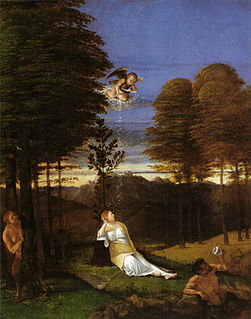 W
WAllegory of Chastity is a c.1505 oil on panel painting by Lorenzo Lotto.
 W
WThe Allegory of Divine Providence and Barberini Power is a fresco by Italian painter Pietro da Cortona, filling the large ceiling of the grand salon of the Palazzo Barberini in Rome, Italy. Begun in 1633, it was nearly finished in three years; upon Cortona's return from Venice, it was extensively reworked to completion in 1639. The Palazzo, since the 1620s, had been the palatial home of the Barberini family headed by Maffeo Barberini, by then Urban VIII, who had launched an extensive program of refurbishment of the city with art and architecture.
 W
WAllegory of Fertility and Abundance is a c.1500 allegorical tempera on panel painting by Luca Signorelli, now in the Uffizi in Florence. Produced around the same time as the artist's frescoes in the San Brizio Chapel in Orvieto, the work was a monochrome allegory inspired by classical bas-reliefs and intended for a humanist scholar's studiolo. Its figures refer to the artist's nudes in his frescoes at Orvieto and Madonna and Child with Ignudi.
 W
WAllegory of Fortune, sometimes also named La Fortuna, is an oil painting on canvas, that was created around 1658 or 1659, by the Italian baroque painter Salvator Rosa, which caused uproar when first exhibited publicly and almost got the painter jailed and excommunicated. Bearing initials but undated, it measures 200.7 by 133 centimetres. Rosa was known for his landscape paintings, but also worked in the sphere of mythology, witchcraft, portraits, and satire. Since 1978 it has been in the J. Paul Getty Museum in Malibu, California.
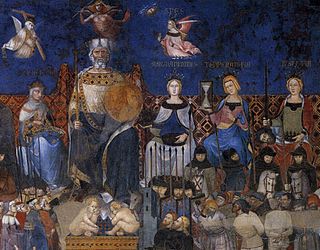 W
WThe Allegory of Good and Bad Government is a series of three fresco panels painted by Ambrogio Lorenzetti between February 1338 and May 1339. The paintings are located in Siena's Palazzo Pubblico—specifically in the Sala dei Nove, the council hall of the Republic of Siena's nine executive magistrates, elected officials who performed executive functions. The paintings have been construed as being "designed to remind the Nine [magistrates] of just how much was at stake as they made their decisions".
 W
WAllegory of Happiness is an oil on copper painting by Bronzino, probably first produced for the Studiolo of Francesco I, signed BROZ. FAC. and now in the Uffizi in Florence. It is now in a fluted and gilded 17th century wooden frame. Most art historians date it to around 1567.
 W
WThe Allegory of Isabella d'Este's Coronation is a painting by the Italian Renaissance painter Lorenzo Costa the Elder, dating to about 1505–1506. It is displayed in the Louvre Museum of Paris, France.
 W
WAllegory of Justice is an oil on panel painting, commissioned on 6 January 1543 from Giorgio Vasari by cardinal Alessandro Farnese for the main room of the Palazzo della Cancelleria in Rome. It and the rest of the Farnese collection were later moved to Naples and it is now in the National Museum of Capodimonte.
 W
WThe Allegory of Prudence is an oil-on-canvas painting attributed to the Italian artist Titian and his assistants. The painting portrays three human heads, each facing in a different direction, above three animal heads. It is in the National Gallery, London.
 W
WThe Battle of Lepanto was a naval engagement that took place on 7 October 1571 when a fleet of the Holy League, a coalition of Catholic Christian states arranged by Pope Pius V, inflicted a major defeat on the fleet of the Ottoman Empire in the Gulf of Patras. The Ottoman forces were sailing westward from their naval station in Lepanto when they met the fleet of the Holy League which was sailing east from Messina, Sicily. The Spanish Empire and the Venetian Republic were the main powers of the coalition, as the league was largely financed by Philip II of Spain and Venice was the main contributor of ships.
 W
WAllegory to the Element Earth is a painting by the Venetian Renaissance artist Leandro Bassano of about 1580, now in The Walters Art Museum, Baltimore.
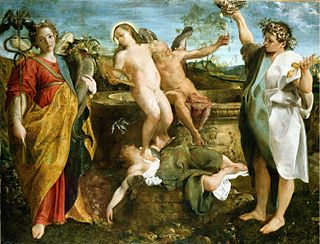 W
WAn Allegory of Truth and Time is a 1584-1585 oil on canvas painting by Annibale Carracci, now on display in Hampton Court as part fo the Royal Collection.
 W
WThe Allegory of Vice is an oil on canvas painting by Correggio dating to around 1531 and measuring 149 by 88 cm. It and Allegory of Virtue were painted as a pair for the studiolo of Isabella d'Este, with Vice probably the second of the two to be completed. This hypothesis is since only one sketch survives for Vice, unlike Virtue, for which several preparatory studies survive, along with a near-complete under-drawing – this suggests Correggio had become more proficient after the difficult gestation of Virtue.
 W
WThe Allegory of Virtue is an oil on canvas painting by Correggio dating to around 1531 and measuring 149 by 88 cm. It and Allegory of Vice were painted as a pair for the studiolo of Isabella d'Este, with Vice probably the second of the two to be completed. This hypothesis is since only one sketch survives for Vice, unlike Virtue, for which two preparatory studies survive, along with a near-complete oil sketch - this suggests Correggio had become more proficient after the difficult gestation of Virtue.
 W
WThe Allegory of Virtue and Vice is a painting by the Italian High Renaissance painter Lorenzo Lotto, dating to 1505. It is housed in the National Gallery of Art in Washington, DC, United States.
 W
WCharity is a 1469 oil on panel painting by Piero del Pollaiolo, now in the Uffizi in Florence.
 W
WCharity is a c.1611 oil on canvas painting by Guido Reni, now in the Galleria Palatina in Florence. It passed into the main Medici collections from that of cardinal Leopoldo de' Medici on his death in 1675. It appears at the top left of Johann Zoffany's Tribuna of the Uffizi (1772-1778).
 W
WCharity is an oil on canvas painting by Guido Reni, now in the Metropolitan Museum of Art, to which it was donated by Mr and Mrs Charles Wrightsman in 1974.
 W
WFaith is a 1470 oil on panel painting by Piero del Pollaiolo, now in the Uffizi in Florence.
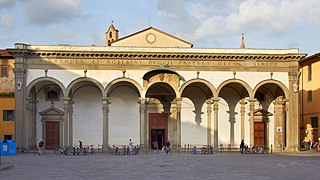 W
WThe Basilica della Santissima Annunziata is a Renaissance-style, Roman Catholic minor basilica in Florence, region of Tuscany, Italy. This is considered the mother church of the Servite Order. It is located at the northeastern side of the Piazza Santissima Annunziata near the city center.
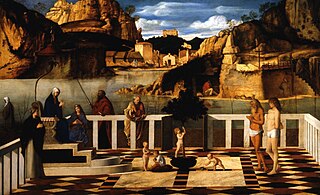 W
WThe Holy Allegory is a painting by the Italian Renaissance master Giovanni Bellini, dating from c. 1490 to 1500. It is in the Uffizi gallery in Florence, Italy.
 W
WHope is a 1470 oil on panel painting by Piero del Pollaiolo, now in the Uffizi in Florence.
 W
WIngenuity is an allegorical Baroque painting by the Bolognese painter Giuseppe Maria Crespi. The painting is also known as Amor Victorious. It is on display in the Musée des Beaux-Arts of Strasbourg, France, to which it had been donated by the collectors Othon Kaufmann and François Schlageter. Its inventory number is 994-1-1, or 44.994.1.1.
 W
WJustice is a 1470 oil on panel painting by Piero del Pollaiolo, now in the Uffizi in Florence.
 W
WMinerva between Geometry and Arithmetic is a 1550 fresco fragment, usually attributed to Paolo Veronese but by some art historians to Anselmo Canera or Giambattista Zelotti. It was painted for the Palazzo de Soranzi in Castelfranco Veneto but now in the Palazzo Balbi in Venice.
 W
WThalia is a c.1546 painting by Michele Pannonio, signed by the artist and produced for the 'studiolo' in Belfiore, begun by Lionello d'Este in 1447 and completed by his brother Borso in 1463. After the palace's destruction by fire in 1632 its paintings were dispersed - Thalia is now in the Museum of Fine Arts in Budapest.
 W
WPrimavera, is a large panel painting in tempera paint by the Italian Renaissance painter Sandro Botticelli made in the late 1470s or early 1480s. It has been described as "one of the most written about, and most controversial paintings in the world", and also "one of the most popular paintings in Western art".
 W
WPrudence is a 1470 oil on panel painting by Piero del Pollaiolo, now in the Uffizi in Florence.
 W
WReligion saved by Spain is an oil on canvas painting produced between 1572 and 1575 by Titian, an Italian master of the Venetian school, commemorating the Battle of Lepanto in 1571. It is one of his later works, and is considered to be an outstanding piece. Other titles are Spain succoring Religion or Religion assisted by Spain.
 W
WSelf-Portrait as the Allegory of Painting, also known as Autoritratto in veste di Pittura or simply La Pittura, was painted by the Italian Baroque artist Artemisia Gentileschi. The oil-on-canvas painting measures 96.5 by 73.7 centimetres and was probably produced during Gentileschi's stay in England between 1638 and 1639. It was in the collection of Charles I and was returned to the Royal Collection at the Restoration (1660) and remains there. In 2015 it was put on display in the "Cumberland Gallery" in Hampton Court Palace.
 W
WTemperance is a 1470 oil on panel painting by Piero del Pollaiolo, now in the Uffizi in Florence. It represents Temperance, one of the seven virtues of the Catholic Church.
 W
WTime orders Old Age to destroy Beauty is a 1746 allegorical oil on canvas painting by the Italian artist Pompeo Batoni. It was commissioned from him by Bartolomeo Talenti, a collector from Lucca, as a pendant for La lascivia, now in the Hermitage Museum. It shows personifications of Time as an old man with a scythe, Old Age as an old woman and Beauty as a young woman. It came into the collection of the Russian count Nikolai Alexandrovich Kushelev-Bezborodko, before being acquired in 1961 by the National Gallery, London where it now hangs.
 W
WTriumph of Chastity is a c.1530 oil on canvas allegorical painting by Lorenzo Lotto, now in the Rospigliosi Pallavicini collection in Rome. It is signed at bottom right "Laurentius Lotus" and shows a female personification of Chastity (left) driving away Cupid and Venus - the Venus is based on that on an ancient Roman sarcophagus now in the Vatican Museums.
 W
WVenus and Mars is an Italian Renaissance painting by Paolo Veronese.
 W
WVenus, Cupid, Folly and Time is an allegorical painting of about 1545 by the Florentine painter Agnolo Bronzino. It is now in the National Gallery, London. Scholars do not know for certain what the painting depicts.
 W
WThe Virgin and Child is an oil painting created by the Italian artist Elisabetta Sirani in 1663; she died two years later at the age of 27. The painting is owned by the National Museum of Women in the Arts in Washington, D.C. Its dimensions are 86 by 70 cm.
 W
WThe Vision of a Knight, also called The Dream of Scipio or Allegory, is a small egg tempera painting on poplar by the Italian Renaissance artist Raphael, finished in 1504–1505. It is in the National Gallery in London. It probably formed a pair with the Three Graces panel, also 17 cm square, now in the Château de Chantilly museum.
 W
WA Young Man Being Introduced to the Seven Liberal Arts, also known as Lorenzo Tornabuoni Presented by Grammar to Prudentia and the other Liberal Arts or Lorenzo Tornabuoni Being Introduced to the Liberal Arts, is a painting by the Italian Renaissance painter Sandro Botticelli, circa 1483–1486. The painting and its companion piece, Venus and the Three Graces Presenting Gifts to a Young Woman, originally decorated Villa Lemmi, a country villa near Florence owned by Giovanni Tornabuoni, uncle of Lorenzo de' Medici and head of the Roman branch of the Medici Bank. They were probably commissioned for the 1486 wedding of Giovanni's son Lorenzo to Giovanna of the Albizzi family, and are therefore thought to depict the two.